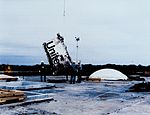Cape Canaveral Launch Complex 5

Cape Canaveral Launch Complex 5 (LC-5) was a launch site at Cape Canaveral Space Force Station, Florida used for various Redstone and Jupiter launches. It is most well known as the launch site for NASA's 1961 suborbital Mercury-Redstone 3 flight, which made Alan Shepard the first American in space. It was also the launch site of Gus Grissom's July, 1961, Mercury-Redstone 4 flight. The Mercury-Redstone 1 pad abort, Mercury-Redstone 1A, and the January, 1961, Mercury-Redstone 2 with a chimpanzee, Ham, aboard, also used LC-5. A total of 23 launches were conducted from LC-5: one Jupiter-A, six Jupiter IRBMs, one Jupiter-C, four Juno Is, four Juno IIs and seven Redstones. The first launch from the complex was a Jupiter-A on July 19, 1956 and the final launch was Gus Grissom's Liberty Bell 7 capsule on July 21, 1961.LC-5 is located next to the Air Force Space and Missile Museum which is located at LC-26. The original launch consoles and computers are on display in the LC-5 blockhouse. As of 2020 a tour of the museum can be arranged through the Kennedy Space Center Visitor Complex's "Cape Canaveral: Early Space Tour". One tour is offered daily, so the number of visitors is limited by the size of the tour.
Excerpt from the Wikipedia article Cape Canaveral Launch Complex 5 (License: CC BY-SA 3.0, Authors, Images).Cape Canaveral Launch Complex 5
Launch Complex 5,
Geographical coordinates (GPS) Address External links Nearby Places Show on map
Geographical coordinates (GPS)
| Latitude | Longitude |
|---|---|
| N 28.439444444444 ° | E -80.573333333333 ° |
Address
Launch Complex 5
Launch Complex 5
Florida, United States
Open on Google Maps






